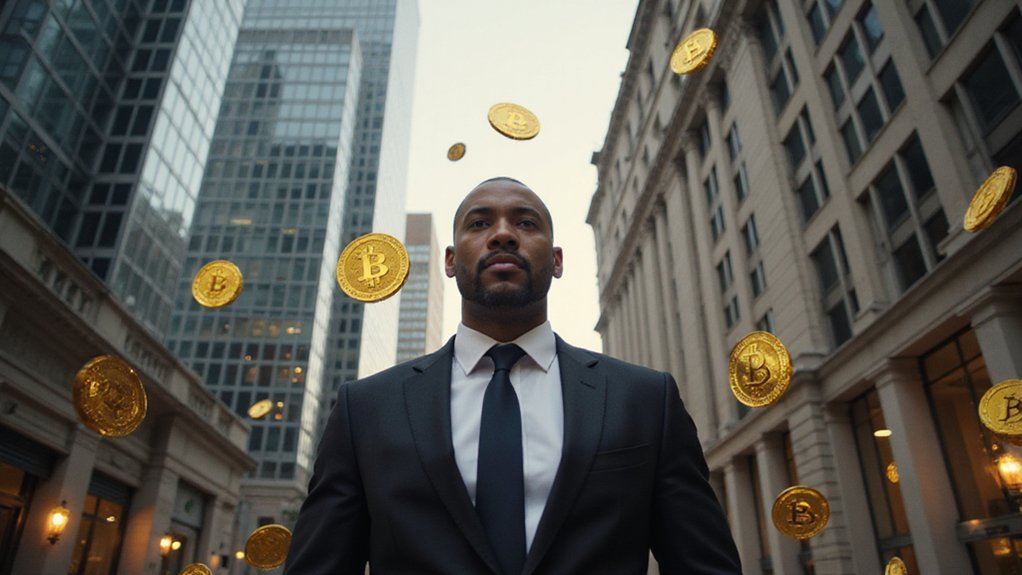Blockchain governance presents an inescapable paradox: systems designed to eliminate central authority require sophisticated governance frameworks to function effectively. Successful models balance on-chain transparency with off-chain deliberation while managing the competing interests of developers, miners, and stakeholders. As networks scale, principles of decentralization, inclusivity, and flexibility become increasingly critical, though implementing them amid divergent economic incentives requires diplomatic finesse. The most resilient protocols transform governance tensions into catalysts for evolution rather than vectors of fragmentation.

Mastering Blockchain Governance
Why does the governance of blockchain networks—ostensibly designed to eliminate central authorities—present such a fascinating paradox in the evolving digital economy? The irony isn’t lost on seasoned observers: systems created to decentralize power inevitably require governance frameworks to function effectively. These digital constitutions must balance the competing interests of developers, miners, stakeholders, and community members while preserving the core ethos of decentralization that attracted participants in the first place.
The bifurcation between on-chain and off-chain governance models represents the fundamental tension in blockchain architecture.
Blockchain governance balances dual realities: code-enforced democracy versus human deliberation, each imperfect yet necessary.
On-chain mechanisms—with their embedded voting protocols and automatic execution features—offer transparency and auditability but occasionally sacrifice the nuanced deliberation that complex decisions demand.
Off-chain approaches, conversely, leverage the rich tapestry of human discussion and social consensus but can devolve into opaque processes dominated by the most vocal (or well-connected) participants.
Many networks have pragmatically adopted hybrid models, recognizing that governance, like markets themselves, rarely benefits from doctrinal purity. Projects like Hyperledger Fabric demonstrate this approach through establishing rules off-chain while allowing protocols to develop on-chain.
The challenges intensify as networks scale.
Decision-making processes that functioned admirably in nascent communities strain under the weight of diverse stakeholders with increasingly divergent economic incentives.
Coordinating protocol upgrades across thousands of nodes requires diplomatic finesse worthy of international relations¹, while the specter of contentious forks looms over every significant disagreement.
The paradox deepens when considering that the very transparency blockchain champions can expose governance processes to strategic manipulation.
Effective governance ultimately requires five interrelated principles: decentralization to prevent control concentration; inclusivity to maintain legitimacy; transparency to foster trust; flexibility to adapt to emerging conditions; and sustainability to prioritize long-term viability over short-term optimization.
Networks that successfully implement these principles through carefully designed consensus mechanisms, voting systems, and community engagement strategies find themselves better positioned to navigate the inevitable conflicts that emerge in any system where valuable resources are at stake.
The mastery of blockchain governance lies not in eliminating conflict, but in channeling it productively toward network evolution. Security and integrity are maintained through strict consensus mechanisms that ensure all participants follow established protocols and rules. These mechanisms employ automated voting processes where nodes collectively verify transactions without relying on centralized authorities.
¹Often with considerably less geopolitical baggage but comparable technical complexity.
Frequently Asked Questions
How Does Blockchain Governance Impact Environmental Sustainability Efforts?
Blockchain governance greatly influences environmental sustainability through its consensus mechanism choices, which determine energy consumption patterns (PoW systems being notoriously power-hungry, while PoS alternatives offer greener alternatives).
Governance frameworks establish incentive structures that either reward or penalize sustainable practices, while simultaneously enabling transparent verification of environmental claims.
The most forward-thinking governance models integrate carbon offset mechanisms, decentralized energy markets, and immutable sustainability metrics—effectively transforming abstract environmental commitments into auditable, tamper-resistant accountability systems.
Can Governance Structures Evolve Without Hard Forks?
Governance structures can indeed evolve without hard forks through several mechanisms—soft forks, off-chain governance, and token-based voting systems being the most prominent.
DAOs exemplify this evolution, allowing stakeholders to implement gradual changes while maintaining network continuity.
Economic incentives and consensus mechanisms (particularly in proof-of-stake systems) further enable governance adaptation without splitting chains.
The challenge lies not in technical feasibility but in aligning disparate stakeholder interests—no small feat in decentralized ecosystems.
What Legal Jurisdictions Apply to Decentralized Governance Systems?
Legal jurisdiction for decentralized governance systems remains a thorny puzzle.
Effect-based and conduct-based approaches compete for relevance, with courts sometimes applying laws based on transaction locations or validation node placement (as in *In re Tezos*).
Nevada’s blockchain-friendly stance—prohibiting local taxation and recognizing blockchain as electronic records—contrasts with more restrictive regimes.
The global, borderless nature of these systems fundamentally demands standardized international frameworks, which, predictably, remain elusive in our stubbornly fragmented regulatory landscape.
How Do Governance Rights Transfer During Token Migrations?
Governance rights transfer during token migrations through a carefully orchestrated process involving smart contract execution, stakeholder consensus, and regulatory compliance.
Token holders typically exchange old tokens for new ones, with governance rights either preserved at a 1:1 ratio or recalibrated based on the migration’s parameters.
The process demands transparent communication and community participation—without which the entire exercise risks becoming an elaborate shell game that undermines the very decentralization it purports to advance.
Can Governance Mechanisms Protect Against Quantum Computing Threats?
Governance mechanisms can offer partial protection against quantum threats, though their effectiveness hinges on implementation speed.
Well-designed frameworks enable timely shifts to quantum-resistant cryptography, while ossified governance structures (Bitcoin’s, particularly) risk paralysis in the face of quantum advancement.
The fundamental challenge isn’t technical—post-quantum algorithms exist—but organizational: can decentralized systems coordinate upgrades before quantum computers render current cryptographic foundations obsolete?
Proactive governance that prioritizes security upgrades represents the most viable defense.









